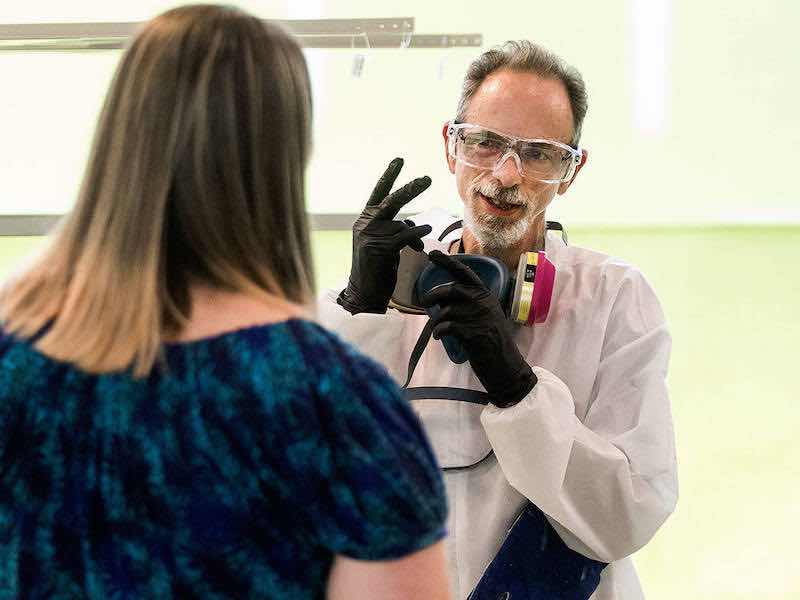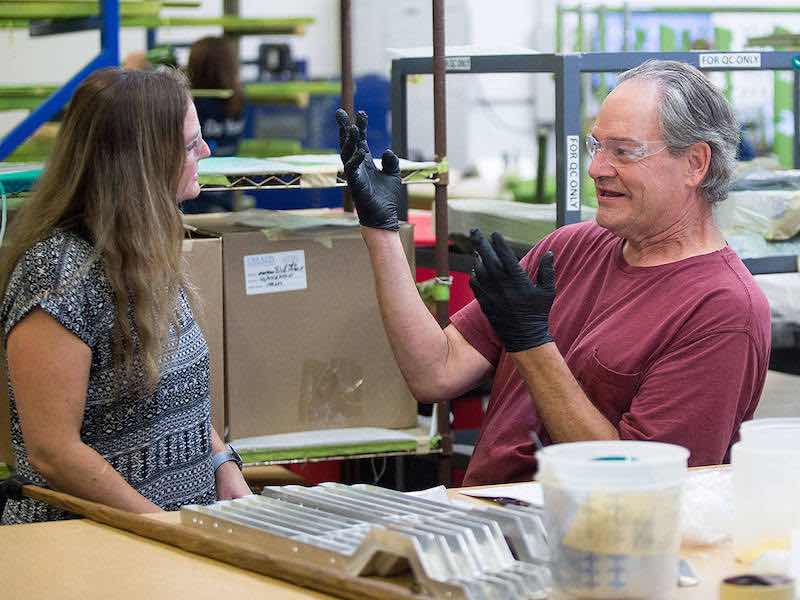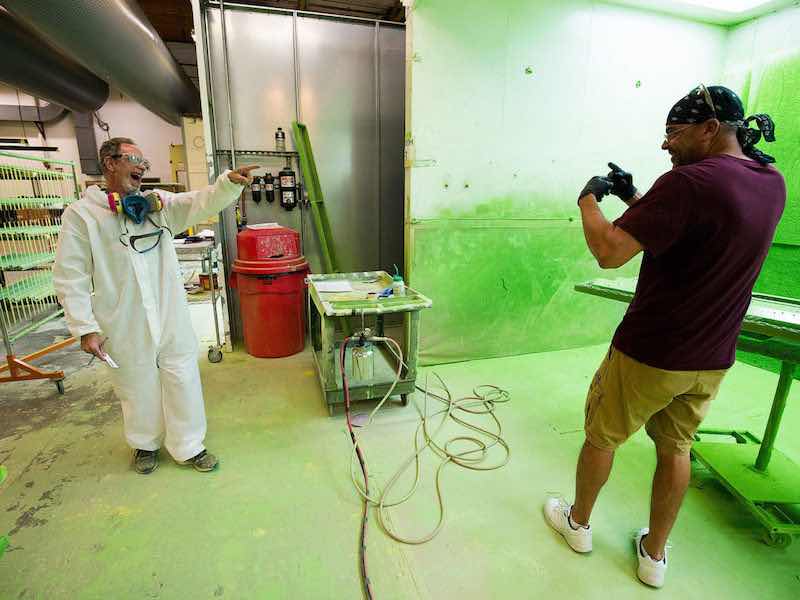Was Mark Vaughn surprised? Did he worry about training the company’s newest hire, a deaf worker?
You bet. We’re talking about safety inside a busy factory.
“I was worried about being able to communicate,” said Vaughn, a painting supervisor at Valence Surface Technologies in Everett, Washington.
In the past year and a half, Valence, an aerospace firm, has hired 10 deaf workers for jobs throughout the plant.
The company cleans, chemically treats, and paints metal components for commercial and military aircraft at 11 locations around the country.
Could a Deaf Worker do the Job? Why Not.
 Daniel Haistings, who is deaf, and Human Resource Manager Jasmin Baker-Kinney use American Sign Language at Valence Surface Technologies in Everett. (Andy Bronson / The Herald)“You have to have faith,” Vaughn said. “You have to spend a little extra time on training. But that’s true of any employee.”
Daniel Haistings, who is deaf, and Human Resource Manager Jasmin Baker-Kinney use American Sign Language at Valence Surface Technologies in Everett. (Andy Bronson / The Herald)“You have to have faith,” Vaughn said. “You have to spend a little extra time on training. But that’s true of any employee.”
Valence, which employs more than 100 people, operates two rapid-pace daytime shifts and a quieter night shift. The yellow safety walkways that traverse the plant are narrow.
Stand too long in one spot, and you’ll be asked to step aside and make way for hand trucks and rolling racks carrying parts from one area of the shop floor to another.
Whether it’s masking, sanding, or painting, “it’s precision work,” said Vaughn. “Everything has to be to spec.”
One of the first deaf workers to be hired was Daniel Haistings. He was assigned to the painting department, which Vaughn oversees.
In the painting booths, metal aerospace parts get a precise layer of green paint to help prevent corrosion.
Fifteen months later, any concerns Vaughn might have had about how everyone would adjust have disappeared. Another deaf worker, Ernie Shinn, recently joined the paint crew.
“I love them both. Daniel is a super hard worker and a fast learner,” Vaughn said. “Ernie is good at lots of different things.”
Haistings, who reads lips, is helping train other deaf workers.
“Daniel helps me communicate. He makes it really easy,” Vaughn said.
And another thing: Hearing employees are taking lessons from their deaf co-workers. They’re learning a new skill, American Sign Language.
In a factory where the rumbling air filtration system drowns out most voices, being able to speak to someone across the room using sign language is an advantage, even safety-wise.
“We’re a labor-intensive company; there’s very little automation,” said Tracy Glende, Valence’s CEO.
Valence serves Boeing, Airbus, Sikorsky, and other aerospace firms. Its finish work is part of the supply chain for the Boeing KC-46 aerial tanker, the Northrup Grumman B-21 long-range bomber, and the Sikorsky Black Hawk helicopter programs.
Every month, the company processes more than a million parts throughout its network, Glende said.
A Tight Labor Market
 Using signs and a bit of lip-reading, masker Brian Jensen communicates with masking supervisor Patsy Caban at Valence Surface Technologies in Everett. (Andy Bronson / The Herald)In the past year or so, Valence’s Everett operation has added about 20 new employees, including 10 deaf workers. Entry-level workers earn $15 an hour to start.
Using signs and a bit of lip-reading, masker Brian Jensen communicates with masking supervisor Patsy Caban at Valence Surface Technologies in Everett. (Andy Bronson / The Herald)In the past year or so, Valence’s Everett operation has added about 20 new employees, including 10 deaf workers. Entry-level workers earn $15 an hour to start.
Finding enough people to fill job openings in a tight labor market can be a challenge for any employer. When the unemployment rate dips below 4% — as it has this past year — the pool of job applicants gets smaller.
Valence isn’t the only Snohomish County employer with “Help wanted” signs on display.
Other local companies struggle to retain workers, despite competitive wages, benefits, and profit-sharing.
“We’ve lost people to Amazon, to Boeing,” Tuanhai Hoang, Qualitel’s President, told Rep. Rick Larsen, who recently toured the electronic assembler’s Everett plant.
“Your standard hire,” someone with experience who shows up on time every day, “everyone wants that person,” said Jasmin Baker-Kinney, human resource manager at Valence.
The current labor shortage has prompted some businesses to step outside their comfort zone and come up with more creative ways to recruit and hire outside the box.
Valence has a history of hiring workers with autism and learning disabilities, Baker-Kinney said.
When the stack of job applications dwindled two years ago, Baker-Kinney contacted Sherwood Community Services in Lake Stevens and Washington Vocational Services in Everett. Both nonprofits serve people with disabilities.
“They reached out to us,” said Janet Bruckshen, executive director of Washington Vocational Services.
“Valence started with a couple people, and then it grew and grew,” Bruckshen said.
Grateful to be Working
 Painting assistant Daniel Haistings (left), a deaf employee at Valence Surface Technologies in Everett, laughs with painter trainer Robert Quinones using American Sign Language. Haistings is one of 10 deaf and hard-of-hearing employees at Valence. Quinones is hearing and knows sign language because his brother is deaf. (Andy Bronson / The Herald)Patsy Caban, a supervisor in the masking department at Valence, is learning how to sign.
Painting assistant Daniel Haistings (left), a deaf employee at Valence Surface Technologies in Everett, laughs with painter trainer Robert Quinones using American Sign Language. Haistings is one of 10 deaf and hard-of-hearing employees at Valence. Quinones is hearing and knows sign language because his brother is deaf. (Andy Bronson / The Herald)Patsy Caban, a supervisor in the masking department at Valence, is learning how to sign.
“Sorry. Thank you, Good job. OK. See you Monday,” said Caban, rattling off her vocabulary list.
“Brian (Jensen) gave me a dictionary for the deaf,” she said, referring to a deaf worker. “I try to read a little each night.”
Olga Ramirez is looking forward to her one-year work anniversary at Valance — “October 22,” Ramirez signed.
Ramirez, 29, signed that this is her first job.
Ramirez’ husband, Eveer Soriano, who works in packaging at Valence, recommended she apply. Now she preps critical aerospace parts for the paint booth.
That kind of work milestone is huge, said Bruckshen, director of Washington Vocational Services.
“A lot of these individuals have been turned down so many times by so many businesses — they’re so grateful,” Bruckshen said.
Still, Valence has incurred additional expenses in accommodating its diverse workforce, Baker-Kinney said.
Sign language interpreters have been hired to translate at weekly staff meetings, safety meetings, and some one-on-one meetings.
“It works out to a few hours a week,” Baker-Kinney said.
“The costs that we have incurred, I don’t think it’s a whole lot more expensive than hiring temporary workers,” she said.
Turnover among disabled workers at Valence has been low. “They just want to do a good job,” Baker-Kinney said.
Valence plans to upgrade its fire alarm system to add flashing lights, but they were going to do that anyway, said Dan Hawkins, regional general manager at Valence.
All of the company’s training videos are now closed-captioned.
Communicating Above the Din
These days, while walking the shop floor at Valence, it’s difficult to tell who’s deaf and who isn’t. Deaf and hearing workers are signing to one another above the din.
Baker-Kinney completed her first year of American Sign Language studies at Everett Community College using the company’s education reimbursement perk.
She starts her second-year courses this fall. “I took sign language in high school. But bringing deaf employees into the workplace re-lighted that flame,” Baker-Kinney said.
“I’ve been with the company three years in October. This is kind of my proudest accomplishment, diversifying the workforce,” she said.
Having a good job has made “a huge difference in our customer’s lives — many have never worked competitively or successfully,” said Bruckshen, the director of Washington Vocational Services. “We’ve worked with people that were living in a car. A job can change that. We get a lot of referrals from friends. They want what their friends have.”
In Washington, the labor participation rate — the percentage of adults who are working full-time or are looking for full-time work — is about 64 percent.
By comparison, the rate for deaf adults regionally and nationally is an estimated 40 percent, according to a recent study by Cornell University’s Yang-Tan Institute.
Why the Gap?
Locally, some deaf workers lost their jobs when electronics manufacturers began moving operations overseas about 10 years ago, Bruckshen said.
Another barrier is the perception that “it’s going to be expensive, making changes at the workplace,” she said.
“Accommodations can be a scary word,” Bruckshen. “It kind of freaks employers out a little bit, but there’s a lot that can be done inexpensively.”
“A $30 flashing light,” for example — “so that a deaf worker with a forklift license can do the job successfully.”
Under the Americans with Disabilities Act of 1990, employers are required to provide reasonable accommodations to qualified employees with disabilities unless doing so would pose an undue hardship.
“Most accommodations we can do for under $10,” Bruckshen said.
“If it’s safety hazards they’re worried about, we can answer their questions. We can come in and do an assessment,” she said.
With the current labor shortage, “a lot more employers are inviting us to the table. There’s less hesitancy,” Bruckshen said.
“Still, we have a long way to go.”
Reprinted with permission of www.HeraldNet.com. Janice Podsada is a business reporter at The Daily Herald, covering Snohomish County’s business community and aerospace. She also writes the monthly Herald Business Journal.


































